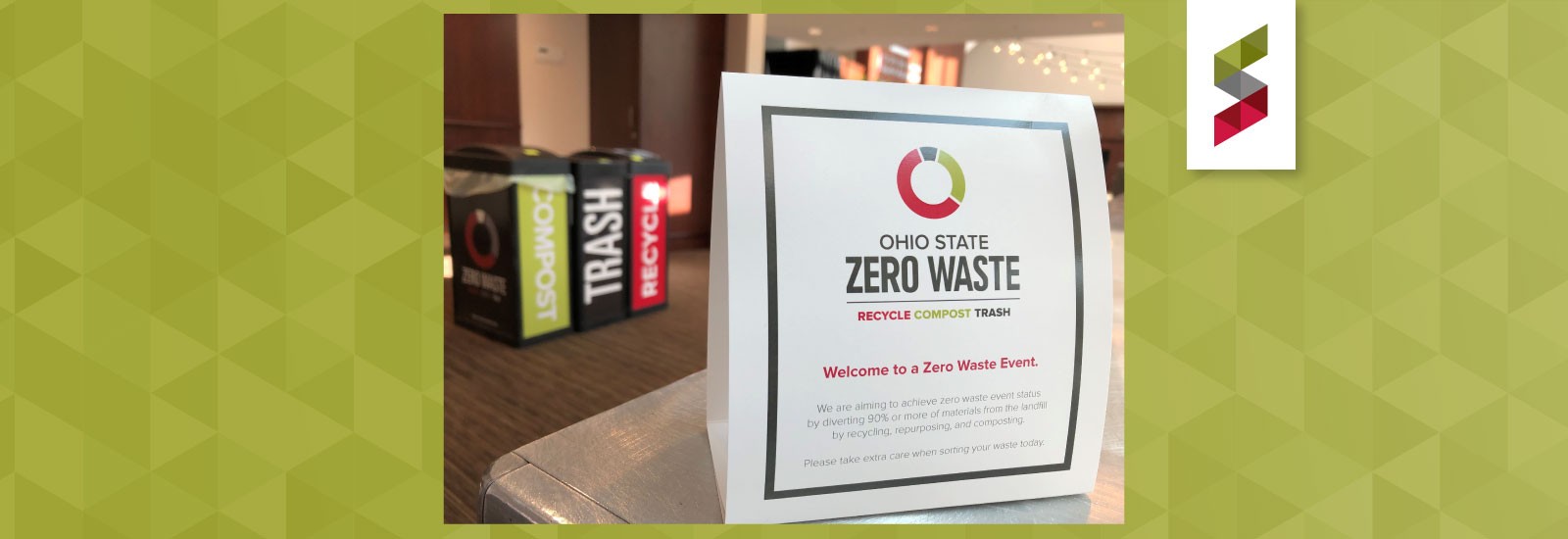In a new collaboration, announced in advance of America Recycles Day Nov. 15, Ohio State and SWACO will share expertise and resources to divert waste from Franklin County’s Sanitary Landfill. They will use Ohio State’s campus as a living laboratory to test waste diversion projects — from education and behavioral change to new recycling technologies — with the aim of scaling up successful strategies across Central Ohio.
“Ohio State and SWACO share a vision to manage solid waste materials in a way to benefit the economy, the environment and the community of Central Ohio,” says Aparna Dial, Ohio State’s senior director of sustainability for Facilities Operations and Development.
Ohio State set a goal for achieving zero waste, which means diverting at least 90% of waste from the landfill, by 2025. The Solid Waste Authority of Central Ohio (SWACO), which serves Franklin County and neighboring areas, aims to divert 75% of all materials away from the Franklin County Landfill by 2032.
“The Ohio State University has ambitious sustainability goals to reduce resource consumption, neutralize carbon emissions and minimize waste,” says Kate Bartter, executive director of the Sustainability Institute at Ohio State. “Our faculty and operations experts work to bring lasting solutions to the Central Ohio community, and we have aspirations to have an impact far beyond our region.”
As Central Ohio’s population grows, so does the amount of waste generated.
“At SWACO, we believe that by working together the Central Ohio region can be a leader in turning our wasted resources into valuable assets that support jobs, benefit our environment and create a more resilient community,” says Kyle O’Keefe, director of innovation and programs for SWACO. “Our collaboration with the university will enable new and creative opportunities for developing waste diversion solutions that help to achieve the university's zero waste goals as well as benefit our entire region.”
Pilot projects will explore opportunities that could include composting of organic waste generated by Ohio State and identifying ways to minimize waste resulting from COVID-19, such as moving from disposable to reusable isolation gowns or looking for new partnerships to recycle single-use plastics prevalent in health care.
Dial emphasizes the value that Ohio State brings to the collaboration through the ability to use the campus as a living laboratory to test pilot projects, which can then be replicated elsewhere.
“The pilot projects provide a learning opportunity for our students by tackling real-world sustainability problems on Ohio State’s campus and by facilitating research. The collaboration not only teaches students how to solve practical problems, but also the value of committing to causes larger than themselves,” Dial says.
“I truly believe that universities are among the most creative and powerful forces for shaping the future,” she adds. “At our best, we prepare students to devote their lives to causes larger than themselves. We bring together scholars whose insights help illuminate and address society’s greatest challenges. We convene conversations that help envision how tomorrow might be better than today.”
The collaboration will not only address downstream solutions but will also prioritize upstream solutions for waste prevention, which requires a coordinated purchasing effort to eliminate waste through careful examination of products bought by Ohio State, she says.
For example, the Wexner Medical Center has tested waste elimination strategies like switching to reusable totes instead of cardboard boxes for shipping items to the hospital from the major health care distributors.
Ohio State researchers will play a significant role in many of the pilot projects by bringing the needed expertise to explore human behaviors that drive waste and recycling practices; new advances in artificial intelligence and big data management to improve decision-making and operational efficiency; and sophisticated simulations to gain insights into the possible impact of new policies through digital modeling.
“This collaboration will help formalize and expand the Ohio State Food Waste Collaborative’s existing relationship with SWACO,” says Brian Roe, director of the collaborative and professor of agricultural, environmental and development economics. The Food Waste Collaborative and the SWACO team obtained $60,000 from the U.S. EPA to conduct an assessment of the “Save More than Food” campaign, which launched throughout central Ohio this fall.
“We think this will really pave the way toward greater harmonization of efforts, which will translate to more innovative and effective efforts to reduce food waste and enhance sustainability both on campus and across the region,” says Roe, who also is an affiliated faculty member of the university’s Sustainability Institute.
